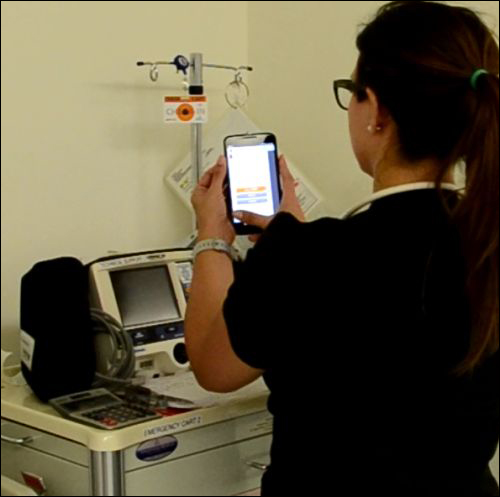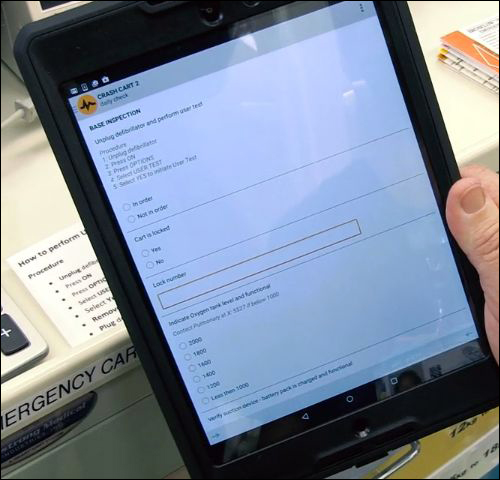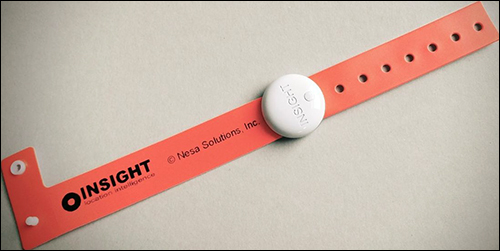Nicklaus Children’s Hospital (formerly known as Miami Children’s Hospital) has deployed Bluetooth Low Energy (BLE) beacons to track assets and some personnel within its emergency department, as well as Near Field Communication (NFC) RFID tags (used with Android-based tablets or smartphones) to conduct daily inventory counts to ensure that 34 crash carts are properly loaded. Startup technology company Nesa Solutions developed the hybrid solution, known as INSIGHT Location Intelligence, to provide location-based intelligence to health care or other sectors. The solution includes modules such as crash cart control, environment of care (EOC) surveys (for managing room inspections) and PINPOINT (for pushing notifications to staff members, patients or visitors).
To date, the technology has helped the medical facility to reduce the amount of time its employees spend inspecting crash carts, from several hours to merely a few minutes each day, according to Edward Martinez, the senior VP and CIO of Miami Children’s Health System (MCHF), the hospital’s parent organization. It also enables the locating of wheelchairs, pumps and other equipment throughout the emergency department, when such items are needed for patient care, based on BLE transmissions. In the long term, though, the hospital aims to know where individuals and items are located, he says, and to use intelligence based on that location data to boost the efficiency and safety of its patient care.

INSIGHT, according to Neil Salem, Nesa Solutions’ CEO and chairman, is a software-as-a-service (SaaS) solution that he refers to as location-based services, which is used to link physical entities to digital processing. “Technology-wise,” he explains, “it can range from bar code to NFC, BLE, RFID and Wi-Fi—anything that will allow unambiguous physical entity identification.”
Nicklaus Children’s Hospital is South Florida’s only licensed specialty hospital exclusively for children. A busy facility, it receives 150,000 emergency room visits annually and is in the process of growing—the hospital is currently building a new six-story bed tower.
Approximately three years ago, Martinez recalls, the hospital began considering how a real-time location system (RTLS) could help track assets’ locations, but from the outset, he says, the hospital’s managers wanted to take a holistic approach regarding how the technology would be used. “You can spend a lot of money without any real value other than knowing where things are,” he explains. Instead, he says, they wanted to know more, such as whether patients were being seen in a timely fashion, if health-care providers were washing their hands prior to each patient visit as required, and whether patient safety could be better protected—for instance, how baby abductions might be prevented.
When it comes to crash cart inspections, says Jose Perdomo, MCHF’s senior VP of facilities and construction and chief compliance officer, “Every hospital, from a regulatory perspective, has to be ready for emergencies, and you never know when that will happen.” It was a daily, time-consuming project, he notes, for hospital personnel to ensure that the oxygen cylinder is loaded, that the equipment is present and that nothing is expired.
Initially, the hospital didn’t find the kind of technology solution it sought. “The interesting thing we found is that in health care, there are all these single solutions available,” Perdomo recalls. The facility wanted a system that would be more flexible and would not be limited to a single application, such as asset tracking or hand hygiene compliance, or one type of technology. For example, he says, using an RTLS solution with battery-powered tags for every application would be prohibitively expensive.
So in 2014, the hospital began working with Nesa to create a hybrid system that it could pilot and phase in incrementally, with low-cost passive NFC RFID tags for cart inventory and patient room checks, as well as BLE RFID tags for monitoring individuals and equipment. The system consists of Nesa Solutions’ software (to manage data, and provide analytics and location-based intelligence), Quuppa BLE beacons and Locators (beacon readers), and Nesa Solutions’ own NFC tags and Bluetooth beacons.
The company is hardware-agnostic, Salem reports. “We do not intend to be a hardware vendor,” he says. “We do intend to achieve a commodity-style offering of location-based services. If that means a specific piece of hardware is not present to support our goal, we will check if it’s within our ability to [temporarily] produce ourselves.”
Nesa Solutions is a joint venture of two companies: Nesa Agencies, of Miami, Fla., and SMART-Solutions of the Netherlands. Salem, who came from Nesa Agencies, and Helmer van der Veer, who came from SMART-Solutions and is now Nesa Solutions’ VP, board member and CPO, combined their knowledge to create a joint venture in 2014. Their goal was to develop a solution employing multiple technologies to help manage data regarding a hospital’s workflow.

Salem says he and van der Veer were striving to develop a health-care automation solution that could cover everything from asset tracking to patient care management, based on the movements of tagged patients and personnel. Existing systems have a siloed (single solution) approach, he says, while RTLS technology for tracking everything and everybody within a facility was too costly. “The cost of RTLS is very expensive,” Salem states, “and you don’t need it for everything.” According to Nesa Solutions, the price of its BLE-based real-time location system is less than that of some other RTLS solutions on the market, but the company provides other technologies that cost even less for applications in which RTLS data is unnecessary.
“By combining different technologies and applying them in a smart manner, no single technology is leading,” Salem says. “That principle frees the way of thinking for effective alternatives. Hence, if NFC can give the same or similar outcome at 99 percent less cost then active RFID, then we use NFC.”
Instead, van der Veer reports, the startup designed a system that would use a variety of technologies, and a single software platform to manage the collected data. “We are keeping it as simple and cost-effective as possible,” he says.
Nicklaus Children’s Hospital has been utilizing the INSIGHT system since Nesa Solutions’ solution was launched in 2014, using NFC technology as well as beacons and locators from Quuppa. Nesa Solutions’ long-term plan is to provide a full workflow-management system that offers intelligence based on the location and linking of assets, staff member and patients. Initially, the hospital has focused on two functions: EOC surveys and crash cart management.
For the EOC surveys, hospital personnel walk through each room, inspecting its safety and cleanliness and completing a questionnaire regarding what they observe. The surveys are carried out to meet internal and external regulatory and compliance requirements. Currently, about a hundred rooms are monitored in this manner. Before the hospital began using the INSIGHT solution, this was typically accomplished manually on paper, and thus could be a time-consuming, multistep process.
With the INSIGHT system, workers fill out questionnaires presented on their NFC-enabled smartphones or tablets. An electronic version is easier to complete, the company reports, since it displays questions, instructions and alerts specific to the room or area being inspected at any given time. Installed within each room is an NFC tag selected and provided by Nesa Solutions, with a unique ID number linked to the room’s ID in the INSIGHT software. An employee taps a tablet or smartphone next to the tag, causing the device’s INSIGHT app to access the questionnaire for that particular room. The individual then walks through the room and follows the listed tasks, such as checking to see whether the hand sanitizer is full and whether the proper medications or manuals are onsite. That data is automatically uploaded to the server, and the INSIGHT software forwards any problems, such as missing items, to the appropriate party.
The EOC surveys are presently underway in only a few rooms, Perdomo says, but they are expected to go live in 172 rooms once the six-story patient tower opens later this year. To date, he says, the quantity of deficiencies that employees accurately note during inspections—everything from a cracked ceiling tile to a hand hygiene container requiring refilling—has increased four-fold with the new technology.
Throughout the past year, Nicklaus Children’s Hospital has also been using the system to manage the inspections of its crash carts. Each cart must be inspected daily to ensure that it contains the correct medications and equipment, that all are functional and that nothing has expired. First, a user taps his or her phone against the passive NFC RFID tag on the cart to gain access to that cart’s inspection instructions via the INSIGHT app. The worker then follows those instructions, inputting such information as a medication being missing or nearing expiration. As with room inspections, the system saves the cart-inspection data so that the hospital has a record of who carried out each inspection, and when it took place.

If employees fail to inspect a given cart by a specified time, the system can issue an alert to a supervisor. Alerts can then be sent to other supervisors at preset times later in the day if the cart remains uninspected. All alerts and requirements are specified in the survey, and a user can set up the alerts according to preferences. Each cart also has a BLE tag to track its location. By using the system to monitor crash carts, Martinez says, the hospital is now assured that each cart is being inventoried daily, and that a digital record is available to Joint Commission inspectors if requested.
“What we have is a very efficient process,” Perdomo says, “but it took time getting the inventory up to date.” That meant that to prepare for the INSIGHT solution’s launch, employees had to account for every item within each cart, remove any that were expired or not needed in a particular cart, and set up a list of items that could be easily reviewed on a tablet, phone screen or computer dashboard. While cart inspections previously took 15 minutes to accomplish manually, the process now takes only two to three minutes to complete using the NFC-based system, and a record is automatically created of that action. Perdomo predicts the system will save nurses 3,000 to 4,000 hours each year that they would previously have spent checking crash cart inventory.
A BLE RTLS deployment has also been in place for a year in the hospital’s emergency department. Assets such as wheelchairs and pumps are tagged with Quuppa’s BLE tags, Martinez says, while a few personnel are wearing the BLE tag attached to a badge to identify their location when they meet with a patient. In the future, patients will wear the BLE wristband. The Quuppa BLE tags will eventually be replaced with Nesa Solutions’ proprietary tags, Salem says. About 100 Quuppa locators have been installed throughout the hospital to date, including 34 within its 25,000-square-foot emergency department, to communicate with BLE tags attached to staff badges, patient wristbands and hospital assets. By this summer, the facility expects to be using a total of about 3,000 BLE tags.
The hospital plans to implement a hand hygiene monitoring application during the next few months, with each employee wearing a BLE badge tag that would transmit an ID number linked to that person’s name and title. Upon entering a patient’s room, a worker would first proceed to the hand hygiene dispenser and press its lever. (In the future, NFC RFID tags could be used to eliminate the need for such a lever.) The INSIGHT system would receive an indication that the dispenser was being used, and would link that action with the ID number transmitted by that individual’s BLE badge tag.
By the third quarter of this year, Martinez says, the new bed tower will be open and the BLE RTLS solution will be in place throughout that part of the facility as well. He expects between 60,000 and 70,000 items to be tagged and tracked via the beacons deployed throughout the facility. In addition, he anticipates having approximately 3,000 beacon-enabled hand hygiene stations in place.
“This is still just the discovery phase for us,” Martinez states. “We’re still in the process of improvement, but our expectations are being met.”




